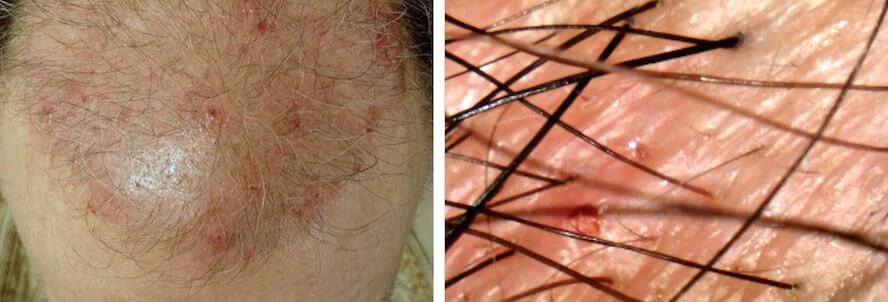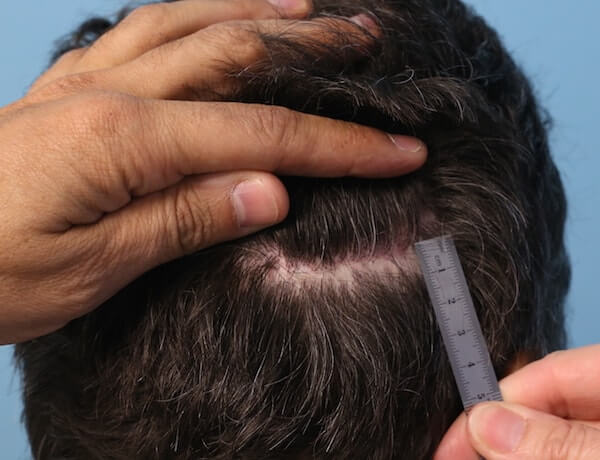Hair Transplant Complications
Hair restoration surgery can be life changing in many ways for patients. However, patients should be made aware of a number of possible hair transplant complications that may occur after undergoing the procedure.
Please note that not every complication listed below will happen to all patients. In fact, the vast majority of patients might not experience any complications. Listed below are some of the most common hair transplant complications patients should be aware of that can occur after a hair transplant:
Early Onset Complications
- Pain– Contrary to what many people believe, there is very little pain during the actual hair restoration surgery. There might be some post-operative pain for the first few days after a strip FUT procedure and patients may require pain medication during the first night after the procedure. FUE typically does not have any pain associated with it even during the first night after the procedure.
- Itching– One common complication following hair transplant surgery is itching of the affected scalp areas. Postoperative scratching in the first 4 days after a hair transplant can be detrimental and result in damage to the newly transplanted grafts. The good news is that itching after hair transplantation is usually minimal and, in most cases, no intervention is needed. Simply keeping the recipient area moisturized with skin moisturizers can alleviate the itching in most cases. If the itching is more severe and persists beyond four days, you need to discuss this with your doctor so he or she can prescribe a mild topical steroid.
- Swelling– Most patients undergoing a hair transplant will see some swelling. In general, swelling is more likely at the transplanted areas and this is especially true over the forehead and around the eyes. Some patients can use prophylactic steroids to minimize the risk of swelling. The steroids could be given through an injection the day of the procedure or by pill for the first few days after a hair transplant. If swelling occurs, it will normally appear at day 3 after the procedure and peak at day 4. Thankfully, the swelling usually subsides rapidly by day 5 after the hair transplant.
- Numbness– Local anesthesia is used for most hair transplant procedures and its effects can last for hours after the hair restoration procedure. The other reason for numbness after the procedure is irritation of the superficial nerves of the skin in the donor or recipient areas. The nerve irritation occurs during the first few days of the healing phase. Occasionally, mechanical damage to the superficial nerve may cause numbness which can last longer. Permanent numbness has been reported after hair transplantation but it is extremely rare if the proper techniques are used during the harvesting of the hair and implanting of the grafts. You need to contact your doctor if your sensation has not completely returned within the first few days after hair transplant surgery.
- Hiccups– Hiccups are a post-surgery complication that can last for several hours or several days. If the hiccups persist for longer than a few hours, patients should call their doctor for medication to treat it.
- Bleeding– The donor area of the scalp is generally covered with a dressing that keeps some light pressure applied to the harvested area whether the procedure is FUE or a strip. This minimizes the risk of bleeding after the hair transplant. There may be some bleeding at the donor or recipient areas of the scalp following the hair transplant. If bleeding occurs, it can usually be stopped by placing some gauze, using light pressure, on the area for a few minutes. Contact your doctor if bleeding is not controlled after a few attempts to stop it by applying pressure.
- Infections – The risk of an infection after any head and neck elective surgery is extremely low thanks to the great blood supply of these areas. Diabetic patients, immune compromised patients and others with a greater risk of infection may be an exception to this rule. For these patients, prophylactic antibiotics may be considered by the doctor.
Late Onset Complications

- Folliculitis – This is an inflammation of the hair follicles that appears as small pimple-like lesions in the transplanted areas or in the donor area of the scalp. Folliculitis usually does not affect the growth of the transplanted hair. Within a few days or weeks, these lesions clear without medication. If you have a persistent painful lesion, or if they become infected, you will need to see your doctor. These lesions can easily be incised and drained in the office.
- Thinning Hair – Many patients may become alarmed following their hair restoration procedure when they discover the native scalp hair they already had has become thinner. This complication is also known as shock loss and can happen after any major stress on the scalp. In hair transplantation, shock loss is due to the stress of the procedure and the healing period that happens within the first few months after a hair transplant. Some mild thinning of the hair is considered an expected consequence of a hair restoration procedure and can easily be mediated by starting prescription medication around the time of the procedure. Patients must continue taking the prescription medication given by the hair transplant surgeon for at least 3 to 6 months to minimize any shock loss. Fortunately, some of the thickness of the hair may return within a few months after surgery. This coincides with the hair follicles entering the resting phase and the growing of new hair shafts.
- Scarring– The development of scarring in the donor area is common in strip procedures. The scar could be as narrow as 1mm or it can occasionally stretch to about 1cm.

A FUE procedure does not cause any linear scarring. Hypertrophic and keloid scars are also rare complications of hair transplants and generally tend to only occur in patients who are predisposed to developing this type of scar.
- Hypopigmentation – After a FUE procedure, there might be some small dotted areas which may appear lighter in color on the donor area. These circular lighter spots used to be a more common complication of hair transplant procedures when larger punches were used to extract the grafts. Today, the size of FUE punches range between 0.7mm and 0.9mm. Therefore, hypopigmentation is very rare with the advent of the smaller size punches currently being used for graft harvesting.